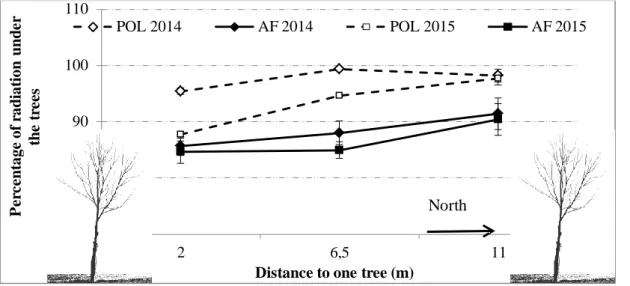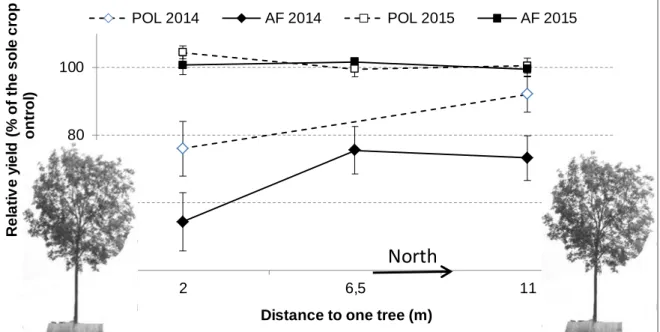HAL Id: hal-02743051
https://hal.inrae.fr/hal-02743051
Submitted on 3 Jun 2020
HAL is a multi-disciplinary open access
archive for the deposit and dissemination of sci-entific research documents, whether they are pub-lished or not. The documents may come from teaching and research institutions in France or abroad, or from public or private research centers.
L’archive ouverte pluridisciplinaire HAL, est destinée au dépôt et à la diffusion de documents scientifiques de niveau recherche, publiés ou non, émanant des établissements d’enseignement et de recherche français ou étrangers, des laboratoires publics ou privés.
Influence of tree pollarding on crop yield in a
mediterranean agroforestry system
Lydie Dufour, Jimmy Le Bec, Christian Dupraz, Jérémy André
To cite this version:
Lydie Dufour, Jimmy Le Bec, Christian Dupraz, Jérémy André. Influence of tree pollarding on crop yield in a mediterranean agroforestry system. 3. European Agroforestry Conference (EURAF 2016), May 2016, Montpellier, France. 466 p. �hal-02743051�
3rd European Agroforestry Conference – Montpellier, 23-25 May 2016 Tree-crop competition and facilitation (oral)
309
INFLUENCE OF TREE POLLARDING ON CROP YIELD
IN A MEDITERRANEAN AGROFORESTRY SYSTEM
L. Dufour *, J. André, J. Le Bec , C. Dupraz Corresponding author* :dufourl@supagro.inra.fr
INRA – UMR System, Bâtiment 27, 2 Place Pierre Viala, 34060 Montpellier Cedex 1, France Introduction
In temperate agroforestry systems, light reduction by the tree canopy is a major cause of the decrease of the cereal yield by up to 50 % near adult trees (Dufour et al., 2013; Reynolds et al., 2007; Rivest et al., 2009). Consequently, practices that can reduce the quantity of light captured by the tree canopy are useful to maintain a profitable cereal yield. When deciduous trees are involved, the time gap between a winter cereal vegetative growth and the budburst of the trees is an asset. The width of the cropped alley and the orientation of the tree rows modify the intensity of the shade even for a given size of trees, and consequently the crop growth and yield (Chirko et al., 1996). Finally, the size and the density of the tree crown has an influence on the shade produced by the tree and consequently on the crop yield. These characteristics can be an intrinsic property of the tree species, but it can be modeled by the man hand by pruning (Jones et al., 1998). Pollarding is a traditional practice consisting in shortening the trunk and applying a repeated pruning of all branches (Chesney, 2012). It results in a distinctive thick bushy appearance of the tree that dramatically reduces the tree leaf area during the first years after pollarding.
The objective of this study was to evaluate the consequence on the crop yield of pollarding the trees in an adult agroforestry field.
Materials and Methods
In December 2013, we pollarded fifty 18-year-old hybrid walnuts that were associated with winter cereals since their plantation, in 1995. The whole tree canopy was cut at 4 m height, using a mobile elevating work platform. The 13 m spaced tree lines were East-West oriented. The cropped alley was 12 m wide. We compared the crop growth and yield in agroforestry plots with pollarded and not pollarded, pruned up to 4 m height, trees to a sole crop control plot. The intercrops were durum wheat in 2013-2014 and winter barley in 2014-2015.
The phenology of the trees and of the crops was recorded weekly. We monitored the growth, yield and yield components of the crops in 1 m² plots: (i) 5 sole crop control plots ;EURAF - Book of Abstracts V9_postimpression.docx (ii) in the agroforestry field we monitored 5 North-South transects of 3 plots located at 2, 6.5 and 11 m from a tree ; (iii) in the agroforestry field with pollarded trees : in 2014, near 5 pollarded trees, in the South and in the North of the alley and in 2015, along 7 transects of 3 plots, as previously described.
The percentage of radiation reaching the crop was calculated from hemispherical photographs taken in the middle of each plot and analyzed with Winscanopy software (Regent Instruments Inc.) at tree budburst (mid-April), at the end of wheat flowering (beginning of May) and at the end of crops grain filling (beginning of June).
Results
The phenology of winter cereals was well adapted to the association with hybrid walnuts as the vegetative growth of the crop is ended when the tree budburst begins (Table 1).
Table 1. Compared phenology of cereals and trees for the 2 years of the study. The dates are the beginning of each cereals stage and of hybrid walnut budburst and the end of walnut short and long shoots expansion.
Sowing Tillering
Bud-burst Flowering Short shoots Grain filling Harvest Long shoots Wheat (‘Claudio’) 13/10/23 13/12/01 14/04/22 14/05/28 14/06/16 Barley (‘Augusta’) 14/11/06 14/12/05 15/04/24 15/05/15 15/06/10 2014 Walnut 04/14 05/15 06/30 2015 Walnut 04/20 05/13 07/05
3rd European Agroforestry Conference – Montpellier, 23-25 May 2016 Tree-crop competition and facilitation (oral)
310
As expected, pollarding the trees strongly reduces the shade of the branches and trunk during the first year at all positions in the cropped alley. But during the second year after pollarding, the North and the middle of the cropped alley between pollarded trees keep a lighter level of shade than the agroforestry plots at the trees budburst. However, the North plots do not exhibit anymore difference between pollarded and not pollarded agroforestry alleys at this moment (Figure 1). This result is confirmed when integrating the radiation received by the crop during its whole cycle (Table 2).
Figure 1. Remaining radiation (% of full sun radiation) under the trees, measured by hemispherical photographs in April. Bars represent the standard errors.
Table 2. Percentage of radiation remaining in the cropped alleys compared to the incident radiation in full sun during the whole crop growth cycle. The intervals are the standard errors.
Near one tree South of the alley (2m)
Middle of the alley (6.5 m)
Near the other tree North of the alley (11 m) Agroforestry with pollarded trees 2014 94.5 1.5 96.3 0.9 98.0 0.3 2015 81.0 2.1 % 95.2 0.4 % 97.0 0.3 % Agroforestry with not pollarded trees 2014 73.6 1.1 84.6 3.3 89.4 2.3 2015 75.9 2.9 % 84.0 1.7 % 89.5 0.8%
The yield of the sole crop control was 4.480.17 t ha-1 for wheat in 2014 and 5.550.15 t ha-1 for barley in 2015. In table 3, the crops yields in the agroforestry plots are reported, with the yield component that is the most impacted by the trees presence: the number of grains per spikes; for the sole crop control, there were 32.80.9 grains of wheat per spike in 2014, 20.60.8 grains of barley per spike in 2015. This yield component is linked to the flowering and/or pollination, phases during which the tree shade occurs.
Table 3. Grain yield (t ha-1) and number of grains per spike in the different agroforestry plots. The intervals are the standard errors.
Near one tree South of the alley (2 m)
Yield Nb of grains
Middle of the alley (6.5 m)
Yield Nb of grains
Near the other tree North of the alley (11 m) Yield Nb of grains Agroforestry with pollarded trees 2014 3.400.36 28.51.4 NA NA 4.130.24 30.21.2 2015 5.470.22 18.80.5 5.330.27 18.00.7 5.350.22 19.10.7 Agroforestry with non-pollarded trees 2014 2.440.38 25.31.9 3.380.32 23.81.8 3.280.30 26.91.3 2015 5.080.18 17.50.3 5.660.36 18.20.7 5.130.15 18.51.0 The relative yields in the agroforestry systems, compared to the sole crop controls are shown in
figure 2. Wheat was much more sensitive to the trees presence than barley. In 2014, the crop
yields near pollarded trees were higher than near not pollarded trees. Southern plots had a 70 80 90 100 110 2 6,5 11 P e rc e n tage of r ad iat ion u n d e r th e t re e s
Distance to one tree (m)
POL 2014 AF 2014 POL 2015 AF 2015
3rd European Agroforestry Conference – Montpellier, 23-25 May 2016 Tree-crop competition and facilitation (oral)
311
lower yield than northern and middle ones, even with a little difference in the quantity of incident radiation, probably due to wheat damage because of the machinery passage during the pollarding operations. The lower yield in the agroforestry non-pollarded plots and in the wheat southern plots can be related to less available light for the crop in these places.
Figure 2. Relative grain yield (% of the sole crop control) in the cropped alleys, in 2014 (wheat) and 2015 (barley). Bars represent the standard errors.
Discussion
Pollarding adult trees in an agroforestry system increased the light available for the associated crops during at least the 2 subsequent years. The wheat was sensitive to the tree shade (Mina et al., 2015); the plots near pollards had a significantly higher yield than near the un-pollarded trees. On the opposite, the barley yield was almost not affected by the trees presence, though the shade was more important in 2015 than in 2014, especially in the South of the cropping alley. This can be due to the fact that during the latter stages of grain filling the crop may utilize stem soluble carbohydrate reserves for grain filling in preference to sustaining current photosynthetic activity (Bingham et al., 2007). A further experiment, with a pea crop, that is very sensitive to the shade, will precise, for the third year after pollarding, if the shade is still modified and how the crop yield is affected. At the same time, a precise following of the trees trunk growth is undertaken in order to determine how the pollarding operation reduces the girth growth of the trees.
References:
Bingham I.J., Blake J., Foulkes M.J., Spink J. (2007) Is barley yield in the UK sink limited? I. Post-anthesis radiation interception, radiation-use efficiency and source-sink balance. Field Crops Research 101:198-211. DOI: 10.1016/j.fcr.2006.11.005.
Chesney P.E.K. (2012) Shoot Pruning and Impact on Functional Equilibrium between Shoots and Roots in
Simultaneous Agroforestry Systems. Agroforestry for Biodiversity and Ecosystem Services, in: M. L. Kaonga (Ed.), Agroforestry for Biodiversity and Ecosystem Services – Science and Practice, www.intechopen.com, Croatia.
Chirko C.P., Gold M.A., Nguyen P.V., Jiang J.P. (1996) Influence of orientation on wheat yield and photosynthetic photon flux density (Qp) at the tree and crop interface in a Paulownia-wheat intercropping system. Forest Ecology and Management 89:149-156.
Dufour L., Metay A., Talbot G., Dupraz C. (2013) Assessing Light Competition for Cereal Production in Temperate Agroforestry Systems using Experimentation and Crop Modelling. Journal of Agronomy and Crop Science 199:217-227. DOI: 10.1111/jac.12008.
Jones M., Sinclair F.L., Grime V.L. (1998) Effect of tree species and crown pruning on root length and soil water content in semi-arid agroforestry. Plant and Soil 201:197-207.
Mina U., Singh S.D., Singh B., Khaund M. (2015) Response of wheat and chickpea cultivars to reduced levels of solar irradiance. Journal of Agrometeorology 17:165-171.
Reynolds P.E., Simpson J.A., Thevathasan N.V., Gordon A.M. (2007) Effects of tree competition on corn and soybean photosynthesis, growth, and yield in a temperate tree-based agroforestry intercropping system in southern Ontario, Canada. Ecological Engineering 29:362-371.
Rivest D., Cogliastro A., Vanasse A., Olivier A. (2009) Production of soybean associated with different hybrid poplar clones in a tree-based intercropping system in southwestern Quebec, Canada, Agriculture, Ecosystems & Environment, Elsevier, Amsterdam Netherlands. pp. 51-60.
40 60 80 100 2 6,5 11 R e la ti v e y ie ld (% o f th e s o le c ro p c o n tr o l)
Distance to one tree (m)
POL 2014 AF 2014 POL 2015 AF 2015


